TL;DR — Folks, it’s a zoo out there, especially when it comes to feature prioritization. Below is yet another O’Rly bookshelf to prove my point …
… so BEHOLD! 5 more ‘wild beasties’ that graze upon our prioritization process. Only this time, the creatures listed below are more about situations we find ourselves in rather than the various personalities that feast upon our product backlogs.
AND just like my original post, each parody book cover is immediately followed by 2 or more relevant blog posts or news articles that provide some deeper insights into how they impact our story valuation decisions.
Oh and BONUS … at the end of this post … 3 ideas for what’s next.
YAK — Yet Another KPI
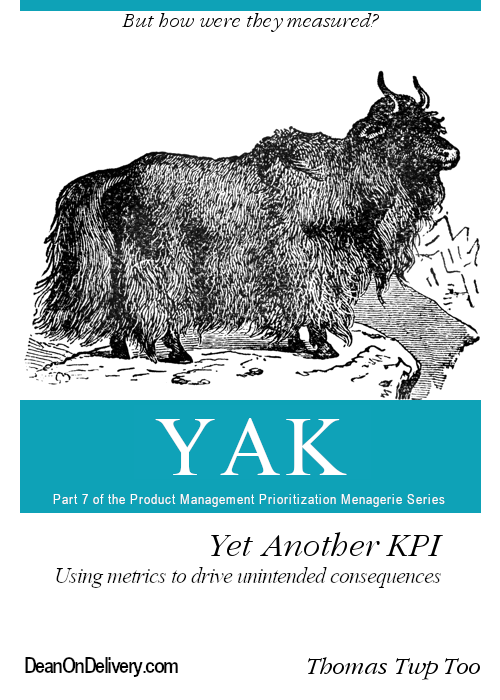
From Chapter 2 of the book ‘Lean Analytics’
“But if you want to change behavior, your metric must be tied to the behavioral change you want. If you measure something and it’s not attached to a goal, in turn changing your behavior, you’re wasting your time.”
I agree with this and would add that if you’re uncertain as to the behavioral change you’re seeking, then you could wind up experiencing the unintended consequences of people behaving differently — or badly — because they realize they’re being stack ranked against a metric that can be ‘gamed.’
Performance & KPI Specialist Stacey Barr writes about this in her article titled ‘When KPIs Drive the Wrong Result.’
Itamar Gilad also offers some insights on how to avoid the insanity of good measures gone bad in his post ‘5 Ways Your Company May Be Misusing OKRs.’
One example of this is with the demise of Stayzilla, an India-based home aggregator that followed the wrong metrics, as described in the article ‘The problem with vanity metrics – how marketers can stay focused.’ There we read the former CEO admitting:
“The initial seven years were all about having negative working capital, positive cash flow and a sustained ability to fund our own growth. Those were the only metrics we tracked. In the last three to four, though, I can honestly state that somewhere I lost my path. I started treasuring GMV [Gross Merchandise Value], room-nights and other ‘vanity’ metrics instead of the fundamentals of cash flow and working capital.”
‘Machiavellians: Gulling the Rubes’ author Dale Hartley, Ph.D. offers some very intriguing real-world examples in his Psychology Today post titled ‘The Cobra Effect: Good Intentions, Perverse Outcomes.’
Put more bluntly, Anthropologist Marilyn Strathern sums such accidental analytics abuse in her generalization of ‘Goodhart’s law’ by stating:
“When a measure becomes a target, it ceases to be a good measure.”
Finally, if you’re interested in measuring your applications the right way, you can’t go wrong with the writings & presentations of Ronny Kohavi. A good place to start would be his CXL Live 2016 video ‘A/B Testing Pitfalls: Getting Numbers You Can Trust is Hard.’
CoBRA — Cognitive Bias-Related Assertions
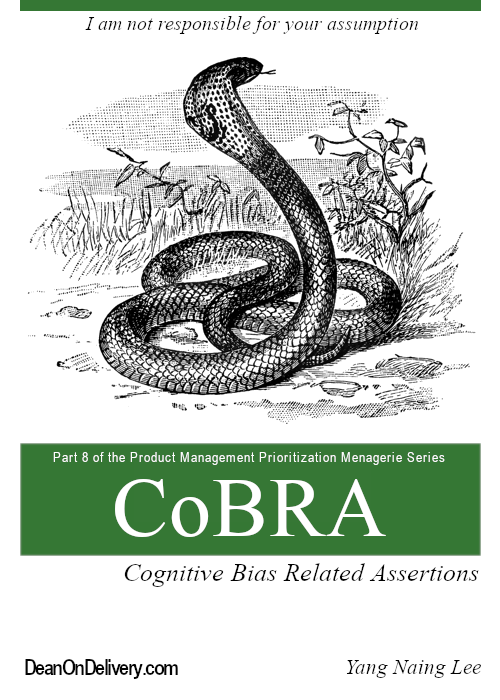
Wow, where do I even start on this topic? IMHO, so many of the appetites driving the ravenous animals on both this post — and my original — are rooted in at least 1 of the 188 biases reflected in the visualization offered via ‘Every Single Cognitive Bias in One Infographic.’ I’d suggest keeping this image in mind when you listen to Cory Bryan’s ‘Deliver It Cast: [114] — Cognitive Bias.’
And since I have you queuing up podcasts, I’d also suggest Christopher Lochhead’s recent interview with Robert Rosenberg titled “190 Lessons Learned From Running Dunkin Donuts For 35 Years.” Pay special attention to the podcast at the point where Rosenberg describes a critical pivot in his own behavior upon realizing his hubris after a read of David Halberstam’s book ‘The Best and The Brightest.’
A similar example can be found in the root cause of Jeffrey Immelt’s failure to lead GE in the post-Jack Welch days. In a post by Liane Davey, she asks ‘Is ‘Success Theater’ Masking Rot in Your Organization?‘ This question based on a famous WSJ article titled ‘How Jeffrey Immelt’s ‘Success Theater’ Masked the Rot at GE,’ a cautionary tale of how a culture that disdained bad news contributed to overoptimistic forecasts and botched strategies.’
This quote from the Entrepreneur post titled ‘Are You Guilty of These 3 Biases That Kill Most Startups?’ says it all:
“In 1992, PepsiCo introduced Crystal Pepsi, a variant of its flagship brand that looked like sparkling water but tasted like soda. Buoyed by its initial success in test markets such as Denver and Sacramento, the company launched it nationally. They ran expensive campaigns, including a Super Bowl ad. The innovation failed terribly in the broader market and was shelved by the end of the year.”
For those looking for some quick reads on this topic written specifically for product peeps:
- “Fourteen Cognitive Biases Common to Product Owners” by Carlton Nettleton
- ‘7 Deadly cognitive biases for product managers/owners/teams’ by Nick Hampson
- ‘Project Bias and the Agile Solution’ by yet another Raleigh, NC local, Michael La Pean
PUMA — Promotes Unusually Meaningless Assumption
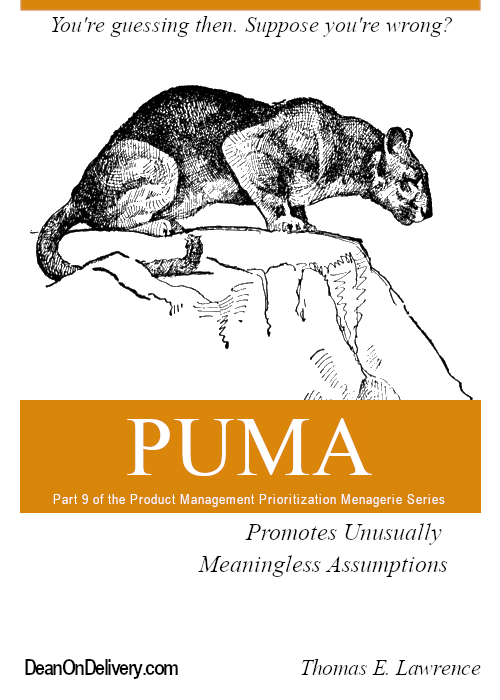
Being old as dirt, I can never discuss the hazards of assumptions without recalling Tony Randall’s hilarious delivery of ‘What Happens When You Assume’ in his role as Felix Unger in the TV show ‘The Odd Couple.’
This situation can happen at a couple of levels. First, let’s deal with how we as people of product sometimes the mistake of running after our own assumptions.
- “Assuming vs. listening: Effectively listening to users’ feedback — part 2” by Marvily Meirav HP
- ‘The Trap of Assumptions’ via Riteek Srivastav
One example of this can be seen via Jimmy Winter’s VoterTide “postmortem” at 1MC Omaha Omaha where we hear:
“We didn’t spend enough time talking with customers and were rolling out features that I thought were great, but we didn’t gather enough input from clients. We didn’t realize it until it was too late. It’s easy to get tricked into thinking your thing is cool. You have to pay attention to your customers and adapt to their needs.”
The Shoes of Prey Journey Ends offers another example as they write:
If I ever find myself in a position where I’m attempting to change consumer behaviour, I will ensure I’ve peeled back the layers to truly understand the psychology of my target customer.
Equally problematic for product owners is dealing with the assumptions of people of political significance in their organization. For that, I offer these three relevant writings:
- ‘Three Cognitive Assumpion Traps that Stifle Global Innovation’ by Simone Ahuja, Ranjan Banerjee, & Neil Bendle
- ‘Why Your RAT (Riskiest Assumption Test) Is The Real MVP’ by Reuben Hall
- ‘Introducing the Riskiest Assumption Canvas’ — Ioannis Nousias
Looking for a real-world example, consider the assumptions made by the short-lived CNN+. There, a network with dwindling numbers somehow assumed that putting content behind a paywall would payout.
GOOSE — Guesstimating Overly Optimistic Scheduling Estimates
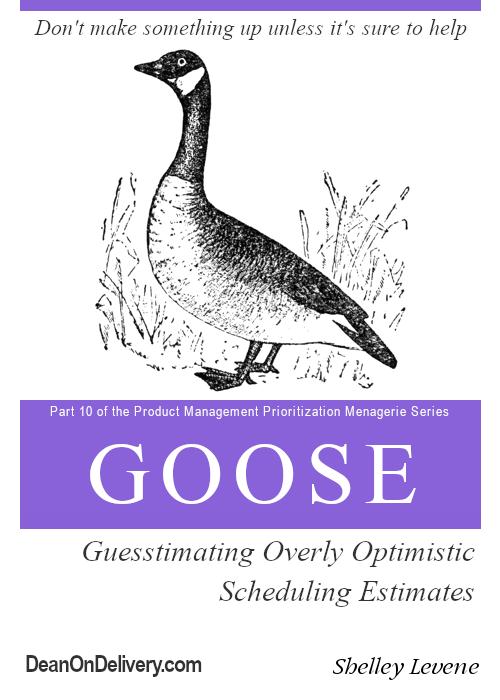
guess·ti·mate
noun, /ˈɡestəmət/ — estimates based on a mix of guesswork & calculation.
verb, /ˈɡestəˌmāt/ — form an estimate based on guesswork & calculation.
guess·ti·mat·ing
verb, present participle, /ˈɡestəˌmātiNG/ — the process of estimating 2 point stories that unfortunately wind up rolling over into the next 3 sprints.
I think you can see where I’m going here.
If not, here’s some science to help drive the point home an academic article titled ‘The optimism bias‘ by Tali Sharot in the December 6, 2011 issue of the Current Biology journal which states:
Humans, however, exhibit a pervasive and surprising bias: when it comes to predicting what will happen to us tomorrow, next week, or fifty years from now, we overestimate the likelihood of positive events, and underestimate the likelihood of negative events.
For example, my definition of ‘Overly Optimistic Scheduling’ comes from a concept Steve McConnell described in his classic ‘Rapid Development: Taming Wild Software Schedules.’ More recently, Steve reached out to me on LinkedIn where he’s updated the concept to simply ‘Overly Optimistic,’ offering additional evidence of this pitfall via his Covid Complete Data Center.
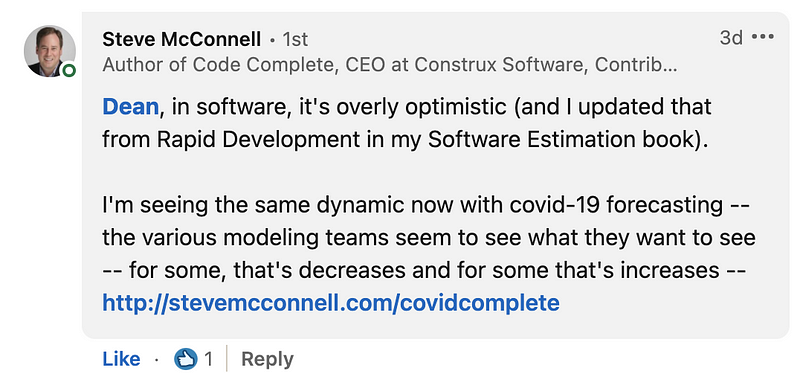
An example of this can be seen in the article ‘The little startup that couldn’t (a postmortem of MyFavorites)’ where we read:
Having a web app being created at the same time was ridiculous too — especially since we still hadn’t nailed down the favoriting process or tried it with any users. I was blowing cash — at a ridiculous pace. I had 7 guys working on this thing at once, as we were hustling for SXSW launch deadline … Focus on one platform. Get it out there — let people use it — nail down the UX with user input.
More on this topic can be learned via these posts:
- ‘Why Great Product Managers Are Optimistic Realists’ by Brian de Haaff
- ‘Optimism vs. Realism: Which Breeds More Entrepreneurial Success?’ by jerry jao
- ‘Why do we overestimate the probability of success?’ via Decision Lab
Serious stuff for sure, though I absolutely love the playful approach to the topic of optimism in the David Kanigan post ‘‘How do YOU see the Glass?”
PUFFIN — Plans unending feature factory initiatives
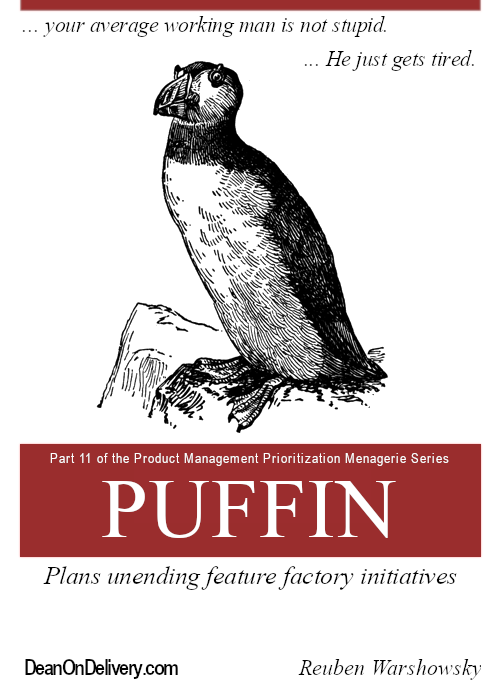
If you are assuming this post was driven by a personal aversion to the types of assumptions that spring out of cognitive biases, well, you wouldn’t be wrong. But of greater importance is to consider the impact such assumptions have on our ability as product owners and product managers to prioritize along valuable customer outcomes … rather than output, opinions, or oligarchy.
I can think of no better embodiment of the output-driven PUFFIN than John Cutler’s seminal post “12 Signs You’re Working in a Feature Factory.”
Perhaps one of the most helpful examples of PUFFINs in the wild is offered by Andrew Jordan Miller in his blog post ‘Going from feature factory to continuous discovery in 1 year.’ There he describes how recognizing he was mired in a world of unending features was the first step to turning the problem around.
Of course, being a big fan of John’s writings, I’d also recommend his equally important follow-up post “12 Signs You’re Working in a Feature Factory — 3 Years Later.”
Finally, I’d also recommend his post “Do This Now: 8 Ways to Focus your Product Team on Impact, Not Features” as he offers insights into how continuous learning via experimentation beats assumptions.
What’s Next?
First, a big shout-out to the ClipArt ETC/FCIT collection for providing the educational illustrations that adorn our book covers.
Second, I’ve already got 3 ferocious animals lined up for one more prioritization menagerie post, so if you’ve got something in mind, let me know and I’ll ensure you get credit for the creature. My bias is in making this the last in this series, as I’m assuming we’ve already had enough of ‘em.
Third, a Podcast for 2021. I’ve already done the validation on the concept, I’ve got all the right equipment & possess mad post-production skills. Now I just need to hit the dang’d record button. If you’re interested, you can follow along at twitter/@pmgrouptherapy. Early adopters on the test run welcome.
If that’s not your deal, I’m always glad to connect via twitter/@deanpeters and linkedin/deanpeters.
SL&TFATF
